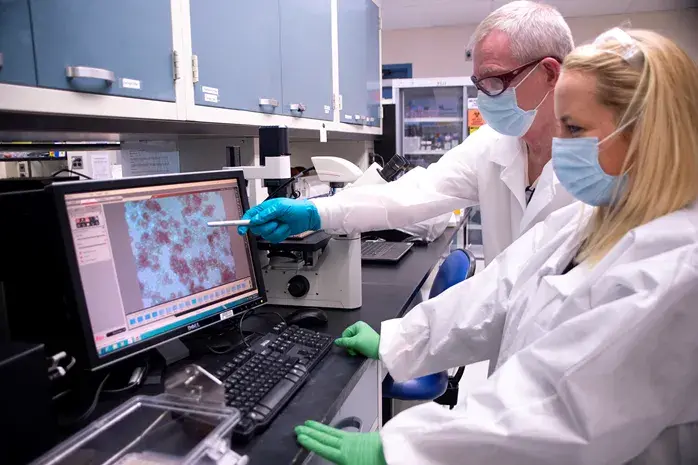The Department of Homeland Security (DHS) Science and Technology Directorate (S&T) is ahead of the pack when it comes to ensuring that the food we eat and our agricultural supply are safe. An attack on our food supply—whether from intentional tampering, or due to contagious animal disease—could be dangerous to human health and could cause long-lasting economic impacts.
 For S&T, food defense is a critical aspect of protecting the nation and our citizens. It is why S&T is working with partners across DHS and other federal agencies to ensure every step in the food supply chain is safe and secure—from farms, where crops and livestock are grown, to manufacturing facilities, where food products are processed, packaged, and then distributed to stores, and on to Americans’ kitchen tables. To achieve this, S&T is developing resources such as risk assessments to help the sector focus on the highest risk areas, so we can trust that the food we eat is safe, especially during a pandemic. These resources include developing tools for preventing and securing food from intentional adulteration during processing, developing animal disease vaccines and detection tools, and studying and characterizing toxic chemicals and pathogens that can contaminate food.
For S&T, food defense is a critical aspect of protecting the nation and our citizens. It is why S&T is working with partners across DHS and other federal agencies to ensure every step in the food supply chain is safe and secure—from farms, where crops and livestock are grown, to manufacturing facilities, where food products are processed, packaged, and then distributed to stores, and on to Americans’ kitchen tables. To achieve this, S&T is developing resources such as risk assessments to help the sector focus on the highest risk areas, so we can trust that the food we eat is safe, especially during a pandemic. These resources include developing tools for preventing and securing food from intentional adulteration during processing, developing animal disease vaccines and detection tools, and studying and characterizing toxic chemicals and pathogens that can contaminate food.
This large and important effort calls for a coalition of top experts: S&T, through its Office of Mission and Capability Support (MCS), the Plum Island Animal Disease Center (PIADC) and the Chemical Security Analysis Center (CSAC), is collaborating with the DHS Countering Weapons of Mass Destruction Office (CWMD) and others across DHS and the federal government, like the U.S. Department of Agriculture. It’s a dream team: CWMD ensures the work meets congressional mandates and has the necessary support; MCS leads the agricultural and veterinary program efforts, and PIADC and CSAC (as part of the S&T’s Office of National Labs) do the science. These organizations contribute to the Food, Agriculture and Veterinary Defense (FAVD) strategic program.
CWMD’s role in food defense is to ensure a level of readiness and resiliency across the food and agriculture sectors, so the country is prepared to absorb and quickly bounce back from catastrophic or other high-consequence food and agricultural events. Through FAVD, CWMD helps provide operational support to other DHS components responsible for inspecting food, agricultural and veterinary products, and aims to identify existing capabilities and gaps. MCS, CWMD, PIADC and CSAC are working together with key external stakeholders to develop a Pre-Harvest Agro-Defense Risk Model to help identify and prioritize these greatest risks to the food and agriculture sectors.
“High-consequence events have the propensity to quickly cascade into other sectors in other infrastructures and touch upon the nexus with national security concerns,” said Mark Wittrock, CWMD division director for Food, Agriculture and Veterinary Defense. “A high-consequence event could be an overseas animal disease that has U.S. customs officers on alert to intercept any contaminated food products, or worse, a zoonotic disease like COVID-19 that jumps from animals to humans in rapid succession, or even someone adding poison to food in a food processing factory."
S&T focuses on preparing for and responding to high-consequence events affecting the food we eat, our agriculture and farm animals. A livestock disease outbreak could be devastating to the economy and food supply. Transboundary animal diseases, which do not currently exist in the United States, are especially important to prevent due to their significant impacts on meat, poultry and dairy production. In collaboration with federal partners, academia (including the DHS Centers of Excellence) and industry, this preventative work spans from funding the development of disease diagnostics, countermeasures and vaccines, to informing decision makers at all levels on how to lessen the impact of introduced diseases.
“PIADC is responsible for protecting the nation from foreign animal diseases, and—in addition to developing vaccines and countermeasures for these threats—the laboratory conducts diagnostic testing for potential foreign animal disease outbreaks on a daily basis,” said PIADC Director Dr. Larry Barrett.
Currently, PIADC scientists are working on the development of an African swine fever vaccine to prevent a devastating transboundary animal disease in domestic and feral swine that could affect food security and global trade. This is just one example of S&T’s scientific efforts.
“African swine fever is the highest transboundary animal disease threat to the U.S. swine industry,” said Kevin Anderson, S&T’s FAVD program manager. “An outbreak would potentially cost the U.S. swine industry as much as $50 billion over 10 years. That is why, highly effective and rapidly deployable countermeasure solutions are urgently needed. S&T’s strength is in the advanced development of vaccines and diagnostics, and also modeling to understand disease introduction and spread.”
To address this need and others, PIADC is developing tools and methods that can help the country prepare, respond and recover in the event of an outbreak of African swine fever, including a rapid field test, a method for disposal of infected swine carcasses via composting in windrows, compiling a chemical disinfectant list suitable for porous and non-porous surfaces, and most recently a Master Question List that can help government decision makers react efficiently and appropriately if the disease arrives in the United States.
In addition to animal disease research, S&T performs the science to understand the threats, vulnerabilities and risks to the food supply. Characterizing these risks helps secure every step of the food processing and distribution supply chain to prevent and mitigate adulteration that could result in sickness or death to consumers. As food travels from farms to our kitchens, it goes through processing, packaging and distribution. Along the route, bad actors could take advantage of vulnerable points to contaminate the food and cause harm (known as intentional adulteration).
“S&T developed and maintains risk assessments for the farm-to-fork continuum to identify and prioritize the highest risks to help focus research, planning, preparedness and response to these types of events,” said Jessica Cox, a CSAC program manager who focuses on chemical threat characterization and food defense.
CSAC developed tools and modeling capabilities to look for potential vulnerabilities during food processing, distribution and consumption to estimate the corresponding consequences if adulteration occurs. These tools can ultimately save lives and money by preventing food adulteration incidents.
 One such tool is the Intentional Adulteration Analysis Tool, which looks at chemicals’ characteristics and calculates risk of adulteration along vulnerable points in production, processing, and distribution. Another tool is the Chemical Consequence and Threat Tool, which consists of six different consequence models, one of which is food. The tool calculates the number of people who are expected to receive a life-threatening, severe or moderate injury based on the concentration and toxicity of the chemical, length of exposure, as well as emergency responses like food recalls and medical mitigation.
One such tool is the Intentional Adulteration Analysis Tool, which looks at chemicals’ characteristics and calculates risk of adulteration along vulnerable points in production, processing, and distribution. Another tool is the Chemical Consequence and Threat Tool, which consists of six different consequence models, one of which is food. The tool calculates the number of people who are expected to receive a life-threatening, severe or moderate injury based on the concentration and toxicity of the chemical, length of exposure, as well as emergency responses like food recalls and medical mitigation.
“There is a great need to protect the food supply because a wide variety of toxic agents can be intentionally and unintentionally put in the food,” Cox said. “And if we're not diligent, these toxic chemicals could reach the consumer and cause injuries, fatalities and economic impacts.”
In line with the Securing Our Agriculture and Food Act, which directs DHS to coordinate with federal, state, industry, academia and international partners to defend the country’s food systems against terrorism and other high-consequence events, CSAC has also been working on laboratory studies to address the risks from chemical adulteration of food. The purpose of one study was to estimate food risk due to chemical contamination by calculating the threat and public health consequences of representative chemicals. The results showed that the number and severity of injuries depended on the toxicity, recall measures, medical treatment of the injured, and if the contaminated food smelled, looked or tasted different, it would likely not be eaten.
“The change of the taste, smell and look of the contaminated food could help in decision making for rapid recall to protect public health,” Cox said.
Another effort CSAC has been working on is characterization of ingested chemical threats. Through laboratory experiments, CSAC will help advance our understanding of key parameters (solubility, stability, toxicity) that affect the risk of potential ingestion. This work centers on understanding which chemicals would not be noticed by physical appearance, taste or smell, but could still be consumed at toxic levels.
“Such chemicals could easily go unnoticed until consumed. Having this understanding will result in effective strategies to reduce the overall food intentional adulteration risk,” Cox said.
Clearly, ensuring our food supply is safe from farm to table is a national security priority, as is the health and well-being of our citizens and our economy. S&T continues to proactively partner with federal agencies and industry, and follows the latest scientific advances to characterize, prevent and mitigate threats every step of the way.
For more information about S&T’s food defense work and related media requests, contact STMedia@hq.dhs.gov.
